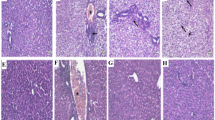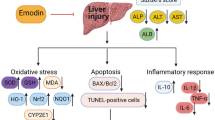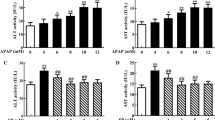Abstract
Gastrodin is a major active phenolic glycoside extract from Gastrodia elata, an important herb used in traditional medicine. Previous research has reported that gastrodin possesses anti-inflammatory and anti-oxidant properties. Therefore, we aimed to investigate its hepatoprotective effects and mechanisms on acetaminophen (APAP)-induced liver injury in a mouse model. Mice included in this study were intraperitoneally administered with a hepatotoxic APAP dose (300 mg/kg). At 30 min after APAP administration, gastrodin was intraperitoneally injected at concentrations of 0, 15, 30, and 45 mg/kg. Then, all mice were sacrificed at 16 h after APAP injection for further analysis. The results showed that gastrodin treatment ameliorated acute liver injury caused by APAP, as indicated by serum alanine aminotransferase level, hepatic myeloperoxidase activity, and cytokine (TNF-α, IL-1β, and IL-6) production. It also significantly decreased hepatic malondialdehyde activity but increased superoxide dismutase activity. In addition, gastrodin decreased ERK/JNK MAPK expression but promoted Nrf2 expression. These results demonstrated that gastrodin may be a potential therapeutic target for the prevention of APAP-induced hepatotoxicity via amelioration of the inflammatory response and oxidative stress, inhibition of ERK/JNK MAPK signaling pathways, and activation of Nrf2 expression levels.






Similar content being viewed by others
Change history
10 May 2022
A Correction to this paper has been published: https://doi.org/10.1007/s10753-022-01679-0
References
Hinson, J.A., D.W. Roberts, and L.P. James. 2010. Mechanisms of acetaminophen-induced liver necrosis. Handbook of Experimental Pharmacology 196: 369–405. https://doi.org/10.1007/978-3-642-00663-0_12.
Kao, L.W., M.A. Kirk, R.B. Furbee, N.H. Mehta, J.R. Skinner, and E.J. Brizendine. 2003. What is the rate of adverse events after oral N-acetylcysteine administered by the intravenous route to patients with suspected acetaminophen poisoning? Annals of Emergency Medicine 42 (6): 741–750. https://doi.org/10.1016/s0196-0644(03)00508-0.
Singh, D., W.C. Cho, and G. Upadhyay. 2015. Drug-induced liver toxicity and prevention by herbal antioxidants: An overview. Frontiers in Physiology 6: 363. https://doi.org/10.3389/fphys.2015.00363.
Bunchorntavakul, C., and K.R. Reddy. 2013. Acetaminophen-related hepatotoxicity. Clinical Liver Disease 17 (4):587–607, viii. doi:https://doi.org/10.1016/j.cld.2013.07.005
Jaeschke, H., M.R. McGill, C.D. Williams, and A. Ramachandran. 2011. Current issues with acetaminophen hepatotoxicity—a clinically relevant model to test the efficacy of natural products. Life Sciences 88 (17–18): 737–745. https://doi.org/10.1016/j.lfs.2011.01.025.
McGill, M.R., M.R. Sharpe, C.D. Williams, M. Taha, S.C. Curry, and H. Jaeschke. 2012. The mechanism underlying acetaminophen-induced hepatotoxicity in humans and mice involves mitochondrial damage and nuclear DNA fragmentation. The Journal of Clinical Investigation 122 (4): 1574–1583. https://doi.org/10.1172/JCI59755.
Jaeschke, H., C.D. Williams, A. Ramachandran, and M.L. Bajt. 2012. Acetaminophen hepatotoxicity and repair: The role of sterile inflammation and innate immunity. Liver International 32 (1): 8–20. https://doi.org/10.1111/j.1478-3231.2011.02501.x.
Krenkel, O., J.C. Mossanen, and F. Tacke. 2014. Immune mechanisms in acetaminophen-induced acute liver failure. Hepatobiliary Surgery and Nutrition 3 (6): 331–343. https://doi.org/10.3978/j.issn.2304-3881.2014.11.01.
Wang, A.Y., L.H. Lian, Y.Z. Jiang, Y.L. Wu, and J.X. Nan. 2010. Gentiana manshurica Kitagawa prevents acetaminophen-induced acute hepatic injury in mice via inhibiting JNK/ERK MAPK pathway. World Journal of Gastroenterology 16 (3): 384–391. https://doi.org/10.3748/wjg.v16.i3.384.
Latchoumycandane, C., C.W. Goh, M.M. Ong, and U.A. Boelsterli. 2007. Mitochondrial protection by the JNK inhibitor leflunomide rescues mice from acetaminophen-induced liver injury. Hepatology 45 (2): 412–421. https://doi.org/10.1002/hep.21475.
Yu, S.M., and S.J. Kim. 2015. The thymoquinone-induced production of reactive oxygen species promotes dedifferentiation through the ERK pathway and inflammation through the p38 and PI3K pathways in rabbit articular chondrocytes. International Journal of Molecular Medicine 35 (2): 325–332. https://doi.org/10.3892/ijmm.2014.2014.
Gum, S.I., and M.K. Cho. 2013. Recent updates on acetaminophen hepatotoxicity: The role of nrf2 in hepatoprotection. Toxicological Research 29 (3): 165–172. https://doi.org/10.5487/TR.2013.29.3.165.
Liu, X.M., K.J. Peyton, A.R. Shebib, H. Wang, and W. Durante. 2011. Compound C stimulates heme oxygenase-1 gene expression via the Nrf2-ARE pathway to preserve human endothelial cell survival. Biochemical Pharmacology 82 (4): 371–379. https://doi.org/10.1016/j.bcp.2011.05.016.
Donovan, E.L., J.M. McCord, D.J. Reuland, B.F. Miller, and K.L. Hamilton. 2012. Phytochemical activation of Nrf2 protects human coronary artery endothelial cells against an oxidative challenge. Oxidative Medicine and Cellular Longevity 2012: 132931. https://doi.org/10.1155/2012/132931.
Lv, H., Q. Xiao, J. Zhou, H. Feng, G. Liu, and X. Ci. 2018. Licochalcone A upregulates Nrf2 antioxidant pathway and thereby alleviates acetaminophen-induced hepatotoxicity. Frontiers in Pharmacology 9: 147. https://doi.org/10.3389/fphar.2018.00147.
Liu, Y., J. Gao, M. Peng, H. Meng, H. Ma, P. Cai, Y. Xu, Q. Zhao, and G. Si. 2018. A review on central nervous system effects of gastrodin. Frontiers in Pharmacology 9: 24. https://doi.org/10.3389/fphar.2018.00024.
Dai, J.N., Y. Zong, L.M. Zhong, Y.M. Li, W. Zhang, L.G. Bian, Q.L. Ai, Y.D. Liu, J. Sun, and D. Lu. 2011. Gastrodin inhibits expression of inducible NO synthase, cyclooxygenase-2 and proinflammatory cytokines in cultured LPS-stimulated microglia via MAPK pathways. PLoS ONE 6 (7): e21891. https://doi.org/10.1371/journal.pone.0021891.
Fang, H., J.C. Zhang, M. Yang, H.F. Li, J.P. Zhang, F.X. Zhang, Q.Y. Wang, R.R. Wang, and J. Liu. 2016. Perfusion of gastrodin in abdominal aorta for alleviating spinal cord ischemia reperfusion injury. Asian Pacific Journal of Tropical Medicine 9 (7): 688–693. https://doi.org/10.1016/j.apjtm.2016.05.007.
Fu, S., L. Chen, Y. Wu, Y. Tang, L. Tang, Y. Zhong, S. Wang, H. Liu, X. Wang, and A. Chen. 2018. Gastrodin pretreatment alleviates myocardial ischemia/reperfusion injury through promoting autophagic flux. Biochemical and Biophysical Research Communications 503 (4): 2421–2428. https://doi.org/10.1016/j.bbrc.2018.06.171.
Li, X.X., Z.H. Jiang, B. Zhou, C. Chen, and X.Y. Zhang. 2019. Hepatoprotective effect of gastrodin against alcohol-induced liver injury in mice. Journal of Physiology and Biochemistry 75 (1): 29–37. https://doi.org/10.1007/s13105-018-0647-8.
McGill, M.R., M. Lebofsky, H.R. Norris, M.H. Slawson, M.L. Bajt, Y. Xie, C.D. Williams, D.G. Wilkins, D.E. Rollins, and H. Jaeschke. 2013. Plasma and liver acetaminophen-protein adduct levels in mice after acetaminophen treatment: Dose-response, mechanisms, and clinical implications. Toxicology and Applied Pharmacology 269 (3): 240–249. https://doi.org/10.1016/j.taap.2013.03.026.
Holt, M.P., L. Cheng, and C. Ju. 2008. Identification and characterization of infiltrating macrophages in acetaminophen-induced liver injury. Journal of Leukocyte Biology 84 (6): 1410–1421. https://doi.org/10.1189/jlb.0308173.
Bradley, J.R. 2008. TNF-mediated inflammatory disease. The Journal of Pathology 214 (2): 149–160. https://doi.org/10.1002/path.2287.
Sierra-Filardi, E., C. Nieto, A. Dominguez-Soto, R. Barroso, P. Sanchez-Mateos, A. Puig-Kroger, M. Lopez-Bravo, J. Joven, C. Ardavin, J.L. Rodriguez-Fernandez, C. Sanchez-Torres, M. Mellado, and A.L. Corbi. 2014. CCL2 shapes macrophage polarization by GM-CSF and M-CSF: Identification of CCL2/CCR2-dependent gene expression profile. The Journal of Immunology 192 (8): 3858–3867. https://doi.org/10.4049/jimmunol.1302821.
Dinarello, C.A. 2018. Overview of the IL-1 family in innate inflammation and acquired immunity. Immunological Reviews 281 (1): 8–27. https://doi.org/10.1111/imr.12621.
Mizrahi, M., T. Adar, G. Lalazar, D. Nachman, M. El Haj, A. Ben Ya’acov, Y. Lichtenstein, Y. Shabat, D. Kanovich, L. Zolotarov, and Y. Ilan. 2018. Glycosphingolipids prevent APAP and HMG-CoA reductase inhibitors-mediated liver damage: A novel method for “safer drug” formulation that prevents drug-induced liver injury. Journal of Clinical and Translational Hepatology 6 (2): 127–134. https://doi.org/10.14218/JCTH.2017.00071.
Wang, Z., W. Hao, J. Hu, X. Mi, Y. Han, S. Ren, S. Jiang, Y. Wang, X. Li, W. Li. 2019. Maltol improves APAP-induced hepatotoxicity by inhibiting oxidative stress and inflammation response via NF-kappaB and PI3K/Akt signal pathways. Antioxidants (Basel) 8 (9). doi:https://doi.org/10.3390/antiox8090395
Mao, X.N., H.J. Zhou, X.J. Yang, L.X. Zhao, X. Kuang, C. Chen, D.L. Liu, and J.R. Du. 2017. Neuroprotective effect of a novel gastrodin derivative against ischemic brain injury: Involvement of peroxiredoxin and TLR4 signaling inhibition. Oncotarget 8 (53): 90979–90995. https://doi.org/10.18632/oncotarget.18773.
Jaeschke H. 2006. Mechanisms of liver injury. II. Mechanisms of neutrophil-induced liver cell injury during hepatic ischemia-reperfusion and other acute inflammatory conditions. American Journal of Physiology-Gastrointestinal and Liver Physiology 290 (6):G1083–1088. doi:https://doi.org/10.1152/ajpgi.00568.2005
Bertola, A., O. Park, and B. Gao. 2013. Chronic plus binge ethanol feeding synergistically induces neutrophil infiltration and liver injury in mice: A critical role for E-selectin. Hepatology 58 (5): 1814–1823. https://doi.org/10.1002/hep.26419.
Marques, P.E., S.S. Amaral, D.A. Pires, L.L. Nogueira, F.M. Soriani, B.H. Lima, G.A. Lopes, R.C. Russo, T.V. Avila, J.G. Melgaco, A.G. Oliveira, M.A. Pinto, C.X. Lima, A.M. De Paula, D.C. Cara, M.F. Leite, M.M. Teixeira, and G.B. Menezes. 2012. Chemokines and mitochondrial products activate neutrophils to amplify organ injury during mouse acute liver failure. Hepatology 56 (5): 1971–1982. https://doi.org/10.1002/hep.25801.
Saito, C., J.J. Lemasters, and H. Jaeschke. 2010. c-Jun N-terminal kinase modulates oxidant stress and peroxynitrite formation independent of inducible nitric oxide synthase in acetaminophen hepatotoxicity. Toxicology and Applied Pharmacology 246 (1–2): 8–17. https://doi.org/10.1016/j.taap.2010.04.015.
Gunawan, B.K., Z.X. Liu, D. Han, N. Hanawa, W.A. Gaarde, and N. Kaplowitz. 2006. c-Jun N-terminal kinase plays a major role in murine acetaminophen hepatotoxicity. Gastroenterology 131 (1): 165–178. https://doi.org/10.1053/j.gastro.2006.03.045.
Bourdi, M., M.C. Korrapati, M. Chakraborty, S.B. Yee, and L.R. Pohl. 2008. Protective role of c-Jun N-terminal kinase 2 in acetaminophen-induced liver injury. Biochemical and Biophysical Research Communications 374 (1): 6–10. https://doi.org/10.1016/j.bbrc.2008.06.065.
Nowak, G. 2002. Protein kinase C-alpha and ERK1/2 mediate mitochondrial dysfunction, decreases in active Na+ transport, and cisplatin-induced apoptosis in renal cells. Journal of Biological Chemistry 277 (45): 43377–43388. https://doi.org/10.1074/jbc.M206373200.
Noh, J.R., Y.H. Kim, J.H. Hwang, G.T. Gang, K.S. Kim, I.K. Lee, B.S. Yun, and C.H. Lee. 2013. Davallialactone protects against acetaminophen overdose-induced liver injuries in mice. Food and Chemical Toxicology 58: 14–21. https://doi.org/10.1016/j.fct.2013.04.005.
Yang, P., Y. Han, L. Gui, J. Sun, Y.L. Chen, R. Song, J.Z. Guo, Y.N. Xie, D. Lu, and L. Sun. 2013. Gastrodin attenuation of the inflammatory response in H9c2 cardiomyocytes involves inhibition of NF-kappaB and MAPKs activation via the phosphatidylinositol 3-kinase signaling. Biochemical Pharmacology 85 (8): 1124–1133. https://doi.org/10.1016/j.bcp.2013.01.020.
Jaeschke, H. 2011. Reactive oxygen and mechanisms of inflammatory liver injury: Present concepts. Journal of Gastroenterology and Hepatology 26 (Suppl 1): 173–179. https://doi.org/10.1111/j.1440-1746.2010.06592.x.
Zhang, H., B. Yuan, H. Huang, S. Qu, S. Yang, and Z. Zeng. 2018. Gastrodin induced HO-1 and Nrf2 up-regulation to alleviate H2O2-induced oxidative stress in mouse liver sinusoidal endothelial cells through p38 MAPK phosphorylation. Brazilian Journal of Medical and Biological Research 51 (10): e7439. https://doi.org/10.1590/1414-431X20187439.
Sun, B., J. Jiang, X. Zhu, D. Yang, Z. Cui, Y. Zhang, M. Zhang, Y. Qian, R. Liu, and W. Yang. 2021. Protective effects of gastrodin pretreatment on mouse hepatic ischemia-reperfusion occurring through antioxidant and anti-apoptotic mechanisms. Experimental and Therapeutic Medicine 21 (5): 471. https://doi.org/10.3892/etm.2021.9902.
Seok, P.R., J.H. Kim, H.R. Kwon, J.S. Heo, J.R. Choi, and J.H. Shin. 2018. Protective effects of Gastrodia elata Blume on acetaminophen-induced liver and kidney toxicity in rats. Food Sci Biotechnol 27 (5): 1445–1454. https://doi.org/10.1007/s10068-018-0374-5.
Lee, I.T., S.F. Luo, C.W. Lee, S.W. Wang, C.C. Lin, C.C. Chang, Y.L. Chen, L.Y. Chau, and C.M. Yang. 2009. Overexpression of HO-1 protects against TNF-alpha-mediated airway inflammation by down-regulation of TNFR1-dependent oxidative stress. American Journal of Pathology 175 (2): 519–532. https://doi.org/10.2353/ajpath.2009.090016.
Yan, H., Z. Huang, Q. Bai, Y. Sheng, Z. Hao, Z. Wang, and L. Ji. 2018. Natural product andrographolide alleviated APAP-induced liver fibrosis by activating Nrf2 antioxidant pathway. Toxicology 396–397: 1–12. https://doi.org/10.1016/j.tox.2018.01.007.
Wang, L., W. Wei, Q. Xiao, H. Yang, and X. Ci. 2019. Farrerol ameliorates APAP-induced hepatotoxicity via activation of Nrf2 and autophagy. International Journal of Biological Sciences 15 (4): 788–799. https://doi.org/10.7150/ijbs.30677.
Gao, Y., S. Chu, Z. Zhang, W. Zuo, C. Xia, Q. Ai, P. Luo, P. Cao, and N. Chen. 2017. Early stage functions of mitochondrial autophagy and oxidative stress in acetaminophen-induced liver injury. Journal of Cellular Biochemistry 118 (10): 3130–3141. https://doi.org/10.1002/jcb.25788.
Zhang, Z., J. Zhou, D. Song, Y. Sun, C. Liao, and X. Jiang. 2017. Gastrodin protects against LPS-induced acute lung injury by activating Nrf2 signaling pathway. Oncotarget 8 (19): 32147–32156. https://doi.org/10.18632/oncotarget.16740.
Qu, L.L., B. Yu, Z. Li, W.X. Jiang, J.D. Jiang, and W.J. Kong. 2016. Gastrodin ameliorates oxidative stress and proinflammatory response in nonalcoholic fatty liver disease through the AMPK/Nrf2 pathway. Phytotherapy Research 30 (3): 402–411. https://doi.org/10.1002/ptr.5541.
Funding
This work was supported in part by grants from the National Science Council (MOST 108–2314-B-182A-059-MY2) and Chang Gung Memorial Hospital (CMRPG3J1561-2) to Fu-Chao Liu and Chang Gung Memorial Hospital (CORPG3G0601) to Chia-Chih Liao.
Author information
Authors and Affiliations
Contributions
C.C.L., H.P.Y., and F.C.L. conceived and designed this study. A.H.C. and H.C.L. carried out experiments. C.C.L. and L.M.H. collected and analyzed data. L.M.H. performed statistical analysis. C.C.L. and H.P.Y. wrote the manuscript, which was critically reviewed and revised by H.C.L. and F.C.L. All authors read and approved the final manuscript.
Corresponding author
Ethics declarations
Ethics Approval
All procedures carried out in this study were approved by the Institutional Animal Care and Use Committee of Chang Gung Memorial Hospital (Taoyuan, Taiwan) (No. 2019091102). All animal experiments were performed according to the guidelines of the Animal Welfare Act and the Guide for Care and Use of Laboratory Animals from the National Institutes of Health.
Conflict of Interest
The authors declare no competing interests.
Additional information
Publisher's Note
Springer Nature remains neutral with regard to jurisdictional claims in published maps and institutional affiliations.
Gastrodin Decreases Hepatotoxicity via MAPK and Nrf2 Signaling Pathways
Chia-Chih Liao and Huang-Ping Yu were equal contributors and co-first authors.
The original online version of this article was revised: The originally published version of this article contained mistakes. The marks "*" and "#" were missing in Figures 3, 4, 5 and 6.
Rights and permissions
About this article
Cite this article
Liao, CC., Yu, HP., Chou, AH. et al. Gastrodin Alleviates Acetaminophen-Induced Liver Injury in a Mouse Model Through Inhibiting MAPK and Enhancing Nrf2 Pathways. Inflammation 45, 1450–1462 (2022). https://doi.org/10.1007/s10753-021-01557-1
Received:
Accepted:
Published:
Issue Date:
DOI: https://doi.org/10.1007/s10753-021-01557-1




